Defence Areas: a national study of Second World War anti-invasion landscapes in England
William Foot, Council for British Archaeology, 2009. https://doi.org/10.5284/1000032. How to cite using this DOI
Data copyright © English Heritage unless otherwise stated
This work is licensed under the ADS Terms of Use and Access.
Primary contact
English Heritage
Kemble Drive
Swindon
SN2 2GZ
England
Tel: 01793 414700
Fax: 01793 414707
Resource identifiers
- ADS Collection: 455
- DOI:https://doi.org/10.5284/1000032
- How to cite using this DOI
Introduction

The preparations for the defence of Britain in 1940/41 against the danger of German invasion represents the high-water mark of Nazi expansion which can be viewed today through the material remains of the defences surviving across the landscape.
To many people of the wartime and later generations, pillboxes and 'dragon's teeth' are iconic of 1940 and Britain's finest hour. Churchill's defiant speech 'We shall fight on the beaches....we shall fight in the fields and in the streets, we shall fight in the hills....' sets out succinctly the types of landscape where the defence works were built and where many still remain. They form a valuable record of our national experience at that time.
The Defence Areas Project was carried out between April 2002 and June 2004 by the Council for British Archaeology, funded by English Heritage. Its overall aim was to build on the results of the Defence of Britain Project (April 1995-March 2002) by examining in more detail anti-invasion defence works that form a coherent and legible grouping and survive well in landscapes largely unchanged from those of 1940/41. The purpose is to promote people's understanding and enjoyment of these defence landscapes, and to encourage them to think of World War Two archaeology at landscape scale. The aim is to ensure greater recognition of the value of these well-preserved landscapes and the need to conserve the components they include, while at the same time recognising that they represent a selection of a much larger number of such places. Some of the surviving components within the landscapes will be recommended for statutory protection. This project represents an original thematic approach to archaeological landscape survey.
These reports have been superseded by the monograph publication, 'Beaches, Streets, Fields and Hills', available here http://www.britarch.ac.uk/books/Foot2006






